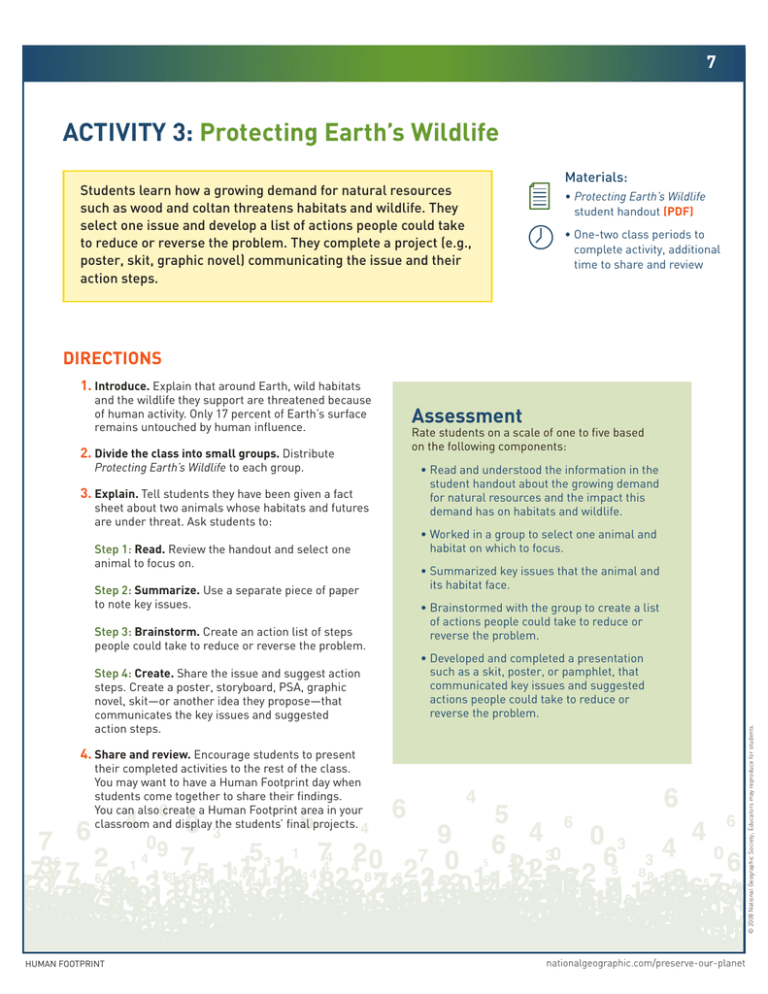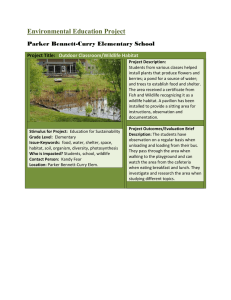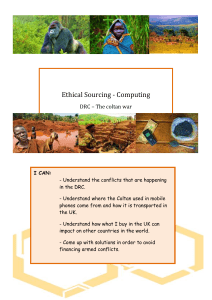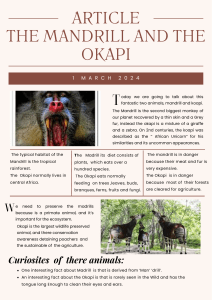AcTIvITy 3: Protecting Earth`s wildlife
advertisement

7 activity 3: Protecting Earth’s Wildlife Students learn how a growing demand for natural resources such as wood and coltan threatens habitats and wildlife. They select one issue and develop a list of actions people could take to reduce or reverse the problem. They complete a project (e.g., poster, skit, graphic novel) communicating the issue and their action steps. Materials: •P rotecting Earth’s Wildlife student handout (PDF) •O ne-two class periods to complete activity, additional time to share and review directions 1. I ntroduce. Explain that around Earth, wild habitats 2. D ivide the class into small groups. Distribute Protecting Earth’s Wildlife to each group. 3. E xplain. Tell students they have been given a fact sheet about two animals whose habitats and futures are under threat. Ask students to: Step 1: Read. Review the handout and select one animal to focus on. Step 2: Summarize. Use a separate piece of paper to note key issues. Step 3: Brainstorm. Create an action list of steps people could take to reduce or reverse the problem. Step 4: Create. Share the issue and suggest action steps. Create a poster, storyboard, PSA, graphic novel, skit—or another idea they propose—that communicates the key issues and suggested action steps. Assessment Rate students on a scale of one to five based on the following components: • Read and understood the information in the student handout about the growing demand for natural resources and the impact this demand has on habitats and wildlife. • Worked in a group to select one animal and habitat on which to focus. • Summarized key issues that the animal and its habitat face. • Brainstormed with the group to create a list of actions people could take to reduce or reverse the problem. • Developed and completed a presentation such as a skit, poster, or pamphlet, that communicated key issues and suggested actions people could take to reduce or reverse the problem. © 2008 National Geographic Society; Educators may reproduce for students. and the wildlife they support are threatened because of human activity. Only 17 percent of Earth’s surface remains untouched by human influence. 4. S hare and review. Encourage students to present their completed activities to the rest of the class. You may want to have a Human Footprint day when students come together to share their findings. You can also create a Human Footprint area in your classroom and display the students’ final projects. HUMan FOOTPRINT nationalgeographic.com/preserve-our-planet Protecting Earth’s Wildlife Name: directions Step 1: Read. Learn about threats to Western lowland gorillas and Okapi, and select one animal to focus on. Step 2: Summarize. Use a separate piece of paper to note key issues. Step 3: B rainstorm. What actions could people take to reduce or reverse the problem? Forests in the Republic of Congo are mined for lumber. The Western lowland gorilla depends on a forest habitat for survival. Rare and shy, okapi are known to live in just one place on Earth, the Democratic Republic of the Congo. Demand for coltan, a valuable mineral, is changing their habitat. Under Threat: Western Lowland Gorillas Under Threat: Okapi The Ndoki-Likouala Landscape, in the Republic of Congo, supports many species including the Western lowland gorilla. This area’s rich biodiversity is under threat because the trees are being cut down—often illegally—to provide wood used to build houses in the United States. The Ituri Forest in the Democratic Republic of the Congo is home to the okapi (pronounced oh-’KAH-pē), a rare mammal that is related to the giraffe. The Congo also contains 80 percent of the world’s known reserves of coltan. This black, tar-like mineral is mined and processed into a heat-resistant powder that is in global demand. Why? It’s used in things like laptop computers, digital cameras, game consoles, cell phones—and many other products. Two million homes are built in the United States each year and an average house uses wood from 64 trees. American houses are doubling and tripling in size, so more lumber is needed. Some of this lumber is coming from places like the Ndoki-Likouala Landscape. Efforts are underway to protect this region’s wildlife and habitat. For example, companies that follow strict environmental and social standards can use a Forest Stewardship Council (FSC) logo on wood they sell. What could people do to reduce the demand for wood products? As the popularity of portable electronic devices increases, so too, does the demand for coltan. One study estimates that cell phone sales will reach one billion a year by 2009. That’s a lot of cell phones—and a lot of coltan. One way to off-set the demand for coltan is to buy fewer cell phones— and recycle the ones you have. Places like the Bronx Zoo, in New York, have drop-off stations where people can recycle old cell phones. A portion of the money raised goes to conservation efforts in the Congo. What could people do to reduce the demand for coltan? Maps © National Geographic Society Maps; Wildlife photographs © Wildlife Conservation Society/Julie Larsen Maher; FSC image used by permission; FSC logo © 2006 FSC HUMan FOOTPRINT nationalgeographic.com/preserve-our-planet © 2008 National Geographic Society; Educators may reproduce for students. Step 4: C reate. Produce a poster, storyboard, PSA, graphic novel, skit—or another idea you come up with—to communicate the issue and your list of actions.







